Optimal Operation Strategy of Ship Power System Under Battle Damage for Enhancing Survivability in Long-Term Missions
Abstract
1. Introduction
2. Modeling and Analysis of Ship Power System (SPS)
2.1. Operational Architecture of SPS
2.2. Conceptual Description and Equipment Modeling Related to SPS
2.2.1. Classification of Operating Conditions Under the Mission
- (1)
- Cruising condition: The ship is currently at a lower risk level, with its main purpose being reconnaissance and navigation. In this state, all types of loads are functioning at normal power.
- (2)
- Combat condition: The ship encounters a significant level of risk; its primary purpose is to engage the enemy and ensure its own safety. Under these circumstances, the ship’s weapon load and defense systems operate at full capacity.
- (3)
- Emergency condition: The ship is currently facing a very high level of risk, and the main goal is to exit the battle to safeguard the ship’s vitality quickly. In this situation, the ship’s power load and defense load operate at increased capacity.
2.2.2. Types and Prioritization of Loads
- (1)
- Mission Load (ML): In the SPS, the Mission Loads mainly include power loads, weapon loads, and defense loads. Their distinctive feature lies in the fact that the operating power magnitude of these loads adjusts according to changes in operating conditions, such as ML1 and ML2 in Figure 2.
- (2)
- Flexible Load (FL): Flexible loads are service class loads that can adjust their power within a specific range, such as air conditioning, and can operate at low power when the ship is damaged, thereby enhancing the flexibility and reserve of system power.
- (3)
- Normal Load (NL): Normal loads in the SPS primarily consist of pumps, piping loads, and similar components. This type of load does not exhibit power characteristics and generally maintains a constant power operation.
2.2.3. Modeling Analysis of Mission Chain
3. Operational Strategies for Energy Storage Cluster Systems
- Scheduling Control Layer: This develops and issues operational plans based on system operational planning and lower-level status information.
- Monitoring management: This monitors information from lower levels, passes it on to higher levels, and implements control according to the operating plan.
- Action Execution Layer: It consists of energy storage units, switches, and converters, which receive commands and execute operations to meet system operation requirements.
- (1)
- The initial damage state of the ESU in the system, along with their varying states of charge (soc) at different time intervals, necessitates real-time monitoring and updating of the operational status of each ESU:
- (2)
- Ships are powered by port and starboard zones, and the energy flow is regional. Regulating the switching state and reconfiguring the ESU area to ensure its spatial uniqueness is crucial.
- (3)
- The power output characteristics of the ESU depend on the converter mode, with different modes suited for different power loads. When the system load changes, the ESU must adjust the mode in real-time to ensure the safety of power and frequency:
4. Survivability Analysis for SPS Frequency Safety Boundaries Supported by Energy Storage
4.1. SPS Frequency Response Model
4.2. Analysis of System Frequency Safety Indicators and the Dynamic Process
4.3. Analysis of Safe Operating Boundaries for System Frequencies
- (1)
- Obtaining the basic operating parameters of each generator and ESU in the system.
- (2)
- Iterate through every operating condition of the generator and every configuration of the ESU to determine the maximum disturbance power that the system can handle and derive the safe power operating range.
- (3)
- Detect and determine the current damage status of the system and identify the minimum configuration requirements of the ESU for each time period based on the extent of the damage and the power of the impact load.
5. Mission Chain-Driven Optimization Strategies for Battle-Damaged Ships
5.1. Objective Function and Operational Constraints of the System
5.1.1. Objective Function
5.1.2. Operational Constraints
- Capacity constraint of generator
- 2
- Topological constraint of the line
- 3
- Power constraint of the system
- 4
- Operational constraint of the ESU
- 5
- Frequency constraint of the system
5.2. Strategy Optimization Framework and Steps
- (1)
- Stage 1: Obtain the relevant operating parameters of the system, detect any damage to the system, and cut off and transfer the load. Optimize the ESU access location reconstruction using the PSO algorithm as a solution.
- (2)
- Stage 2: Based on the reconstruction results and the mission instructions for Stage 1, obtain status information for the generators, ESU, and loads in each subsystem, optimize the power and mode configurations for the load and energy storage, and use the CPLEX solver to solve.
6. Simulation Analysis
6.1. Simulation Parameter Setting
- The auxiliary generators G2 and G4 were destroyed; (50% reduction in generation capacity);
- The primary power supply lines for L3 and L8 are damaged;
- The power supply lines from ESU2 to System 1 are damaged (30% reduction in energy storage capacity);
- The supercapacitor is damaged, and L17 is directly connected to the AC power grid.
6.2. Analysis of Simulation Results
6.2.1. Analysis of the Results of the Stage 1
| Status of the Main Generator | Status of the Auxiliary Generator | Number of ESU in Frequency Support Mode | The Total of the Power Values of the Loads |
|---|---|---|---|
| Yes | No | 0 | [0~120) |
| Yes | No | 1 | [120~270) |
| Yes | No | 2 | [270~410) |
6.2.2. Analysis of the Results of the Stage 2
- (1)
- Optimization of loads
- The general ML and IL in the system are all primary loads, and their weight values are consistently much higher than those of other load types within the mission chain. Consequently, their proportion is always maintained at 100%.
- The FL and NL include secondary and tertiary loads, and their proportion varies with changing working conditions; the overall proportion of the system also shifts with these conditions, generally conforming to the principle that low-power-deficiency conditions have a higher proportion, while high-power-deficiency conditions have a lower one.
- (2)
- Optimization of the ESU
6.3. Comparative Analysis of Strategies
6.3.1. Analysis of Optimization Results for Different Strategies
6.3.2. Analysis of Optimization Measures for ESU
- (1)
- Analysis of the advantages of ESU’s multi-support mode
- (2)
- Analysis of the advantages of the ESU centralized distribution solution
7. Conclusions
- The system’s support capacity under battle damage is inherently constrained. Therefore, it is critical to dynamically allocate energy storage resources and adjust load profiles based on real-time damage assessments in order to sustain power supply to mission-critical loads and maximize survivability.
- The proposed Energy Storage Cluster Management system (ECM) significantly improves both the frequency safety margin and operational adaptability. By utilizing multi-mode support and centrally coordinated configuration, the ECM ensures accurate matching between power supply and diverse load demands, thereby strengthening the system’s resilience and enabling reliable completion of mission chains under adverse conditions.
Author Contributions
Funding
Data Availability Statement
Conflicts of Interest
Appendix A
- (1)
- The relevant parameters of the multi-machine system model are calculated as follows:
- (2)
- The parameters related to energy storage are determined as follows:
- (3)
- Other relevant system parameters are calculated as follows:
Appendix B
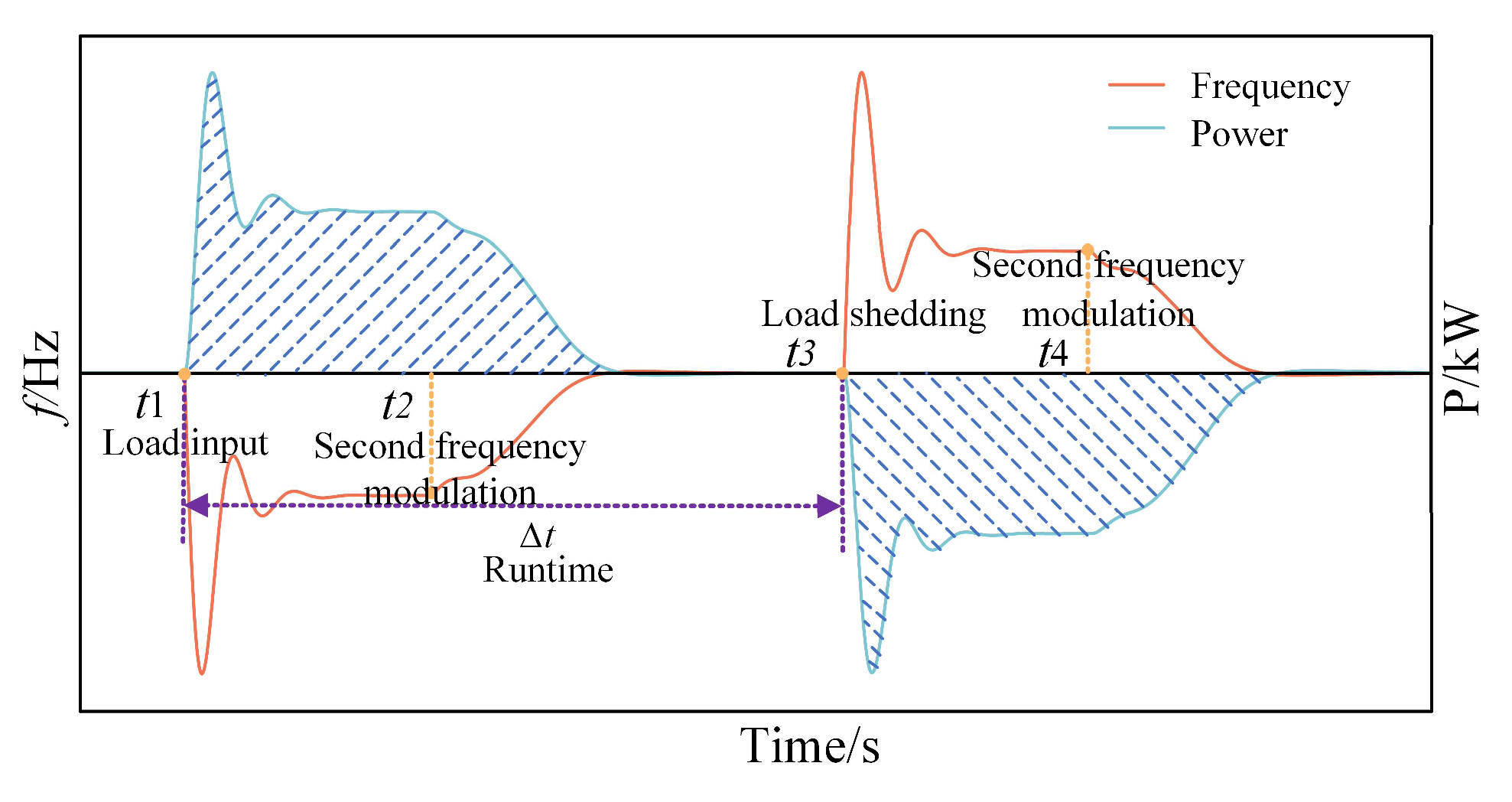
Appendix C
| Load | PL,i/kW | Prioritization | Type | Weight | System |
|---|---|---|---|---|---|
| L1 | 75/125/200 | Primary | ML | 20/18/23 | 1 |
| L2 | 100/200/150 | Primary | ML | 22/20/16 | 1 |
| L3 | 170/270/320 | Primary | ML | 18/23/25 | 2 |
| L4 | 130/200/280 | Primary | ML | 20/12/25 | 2 |
| L5 | 100 | Primary | ML | 5/14/10 | 1 |
| L6 | 120 | Tertiary | NL | 7/10/6 | 1 |
| L7 | 105 | Tertiary | NL | 6/7/10 | 1 |
| L8 | 95 | Secondary | NL | 10/4/13 | 1 |
| L9 | 135 | Secondary | NL | 7/10/15 | 2 |
| L10 | 120 | Tertiary | NL | 5/8/11 | 2 |
| L11 | 160 | Tertiary | NL | 7/4/9 | 2 |
| L12 | 115 | Secondary | NL | 11/6/13 | 2 |
| L13 | 50/100/180 | Secondary | FL | 10/5/12 | 1 |
| L14 | 40/80/140 | Tertiary | FL | 6/11/9 | 1 |
| L15 | 60/130/200 | Secondary | FL | 12/7/11 | 2 |
| L16 | 70/110/160 | Tertiary | FL | 5/10/8 | 2 |
| L17 | 100/250/400 | Primary | IL | 20/25/30 | 1 |
| Generator | S/kVA | HG/s | TG/s | KG |
|---|---|---|---|---|
| G1 | 1000 | 4 | 2.5 | 20 |
| G2 | 1000 | 4 | 2.5 | 20 |
| G3 | 500 | 4 | 2.5 | 20 |
| G4 | 500 | 4 | 2.5 | 20 |
| ESU | S/kVA | HE/s | TG/s | KG |
|---|---|---|---|---|
| 1 | 300 | 4 | 0.5 | 15 |
| 2 | 300 | 4 | 0.5 | 15 |
| 3 | 300 | 4 | 0.5 | 15 |
| 4 | 300 | 4 | 0.5 | 15 |
References
- Frangopoulos, C.A. Developments, Trends, and Challenges in Optimization of Ship Energy Systems. Appl. Sci. 2020, 10, 4639. [Google Scholar] [CrossRef]
- Liang, Z.; Zhu, W.; Shi, J.; Zhu, Z.; Zhi, P. Ship Integrated Power System reconfiguration research under partial observation. Energy Rep. 2022, 8, 444–452. [Google Scholar] [CrossRef]
- Babaei, M.; Shi, J.; Abdelwahed, S. A survey on fault detection, isolation, and reconfiguration methods in electric ship power systems. IEEE Access 2018, 6, 9430–9441. [Google Scholar] [CrossRef]
- Zhang, T.; Wu, D.; Li, L.; Yamashita, A.S.; Huang, S. A fault reconfiguration strategy based on adjustable space operator discrete state transition algorithm for ship microgrid system. Electr. Power Syst. Res. 2022, 205, 107707. [Google Scholar] [CrossRef]
- Wang, C.; Liu, Y.; Zhao, Y. Application of dynamic neighborhood small population particle swarm optimization for reconfiguration of shipboard power system. Eng. Appl. Artif. Intell. 2013, 26, 1255–1262. [Google Scholar] [CrossRef]
- Zhang, X.; Xiao, J.; Wang, X. Research on fault reconstruction algorithm of electric shipboard power system. In Proceedings of the 2021 3rd International Conference on Intelligent Control, Measurement and Signal Processing and Intelligent Oil Field (ICMSP), Xi’an, China, 23–25 July 2021; pp. 164–168. [Google Scholar]
- Han, S.; Yang, J.; Zhan, X.; Wu, D. Fault Reconstruction Strategy for Ship Power Systems Considering Reliability Constraints. Power Syst. Prot. Control 2020, 48, 14–21. [Google Scholar] [CrossRef]
- Zhu, W.; Shi, J.; Zhi, P.; Fan, L.; Lim, G.J. Distributed reconfiguration of a hybrid shipboard power system. IEEE Trans. Power Syst. 2020, 36, 4–16. [Google Scholar] [CrossRef]
- Doerry, N. Naval power systems: Integrated power systems for the continuity of the electrical power supply. IEEE Electrif. Mag. 2015, 3, 12–21. [Google Scholar] [CrossRef]
- McCoy, T.J. Integrated power systems—An outline of requirements and functionalities for ships. Proc. IEEE 2015, 103, 2276–2284. [Google Scholar] [CrossRef]
- Kim, S.-Y.; Choe, S.; Ko, S.; Sul, S.-K. A naval integrated power system with a battery energy storage system: Fuel efficiency, reliability, and quality of power. IEEE Electrif. Mag. 2015, 3, 22–33. [Google Scholar] [CrossRef]
- Choi, E.; Kim, H. Advanced Energy Management System for Generator–Battery Hybrid Power System in Ships: A Novel Approach with Optimal Control Algorithms. J. Mar. Sci. Eng. 2024, 12, 1755. [Google Scholar] [CrossRef]
- Hong, S.H.; Kim, D.M.; Kim, S.J. Power Control Strategy Optimization to Improve Energy Efficiency of the Hybrid Electric Propulsion Ship. IEEE Access 2024, 12, 22534–22545. [Google Scholar] [CrossRef]
- Moghadam, H.M.; Khooban, M.H.; Dragicevic, T.; Masoudian, A. Using interval type2 fuzzy controller in ship power systems in presence of pulsed power loads. In Proceedings of the 2018 IEEE International Conference on Electrical Systems for Aircraft, Railway, Ship Propulsion and Road Vehicles & International Transportation Electrification Conference (ESARS-ITEC), Nottingham, UK, 7–9 November 2018; pp. 1–6. [Google Scholar]
- Sarrias-Mena, R.; Fernandez-Ramirez, L.M.; Garcia-Vazquez, C.A.; Ugalde-Loo, C.E.; Jenkins, N.; Jurado, F. Modelling and control of a medium-voltage DC distribution system with energy storage. In Proceedings of the 2016 IEEE International Energy Conference (ENERGYCON), Leuven, Belgium, 4–8 April 2016; pp. 1–6. [Google Scholar]
- Othman, M.; Anvari-Moghaddam, A.; Ahamad, N.; Chun-Lien, S.; Guerrero, J.M. Scheduling of power generation in hybrid shipboard microgrids with energy storage systems. In Proceedings of the 2018 IEEE International Conference on Environment and Electrical Engineering and 2018 IEEE Industrial and Commercial Power Systems Europe (EEEIC/I&CPS Europe), Palermo, Italy, 12–15 June 2018; pp. 1–6. [Google Scholar]
- Accetta, A.; Pucci, M. Energy management system in DC micro-grids of smart ships: Main gen-set fuel consumption minimization and fault compensation. IEEE Trans. Ind. Appl. 2019, 55, 3097–3113. [Google Scholar] [CrossRef]
- Ibrahim, L.O.; Chung, I.-Y.; Youn, J.; Shim, J.W.; Sung, Y.-M.; Yoon, M.; Suh, J. Coordinated frequency control of an energy storage system with a generator for frequency regulation in a power plant. Sustainability 2022, 14, 16933. [Google Scholar] [CrossRef]
- Fang, C.; Tang, Y.; Ye, R.; Lin, Z.; Zhu, Z.; Wen, B.; Ye, C. Adaptive control strategy of energy storage system participating in primary frequency regulation. Processes 2020, 8, 687. [Google Scholar] [CrossRef]
- Yu, J.; Liao, S.; Xu, J. Frequency control strategy for coordinated energy storage system and flexible load in isolated power system. Energy Rep. 2022, 8, 966–979. [Google Scholar] [CrossRef]
- Shi, Q.; Li, F.; Cui, H. Analytical method to aggregate multi-machine SFR model with applications in power system dynamic studies. IEEE Trans. Power Syst. 2018, 33, 6355–6367. [Google Scholar] [CrossRef]
- Zhu, D.; Zhang, Y.-J.A. Optimal coordinated control of multiple battery energy storage systems for primary frequency regulation. IEEE Trans. Power Syst. 2018, 34, 555–565. [Google Scholar] [CrossRef]
- Anderson, P.; Mirheydar, M. A low-order system frequency response model. IEEE Trans. Power Syst. 1990, 5, 720–729. [Google Scholar] [CrossRef]
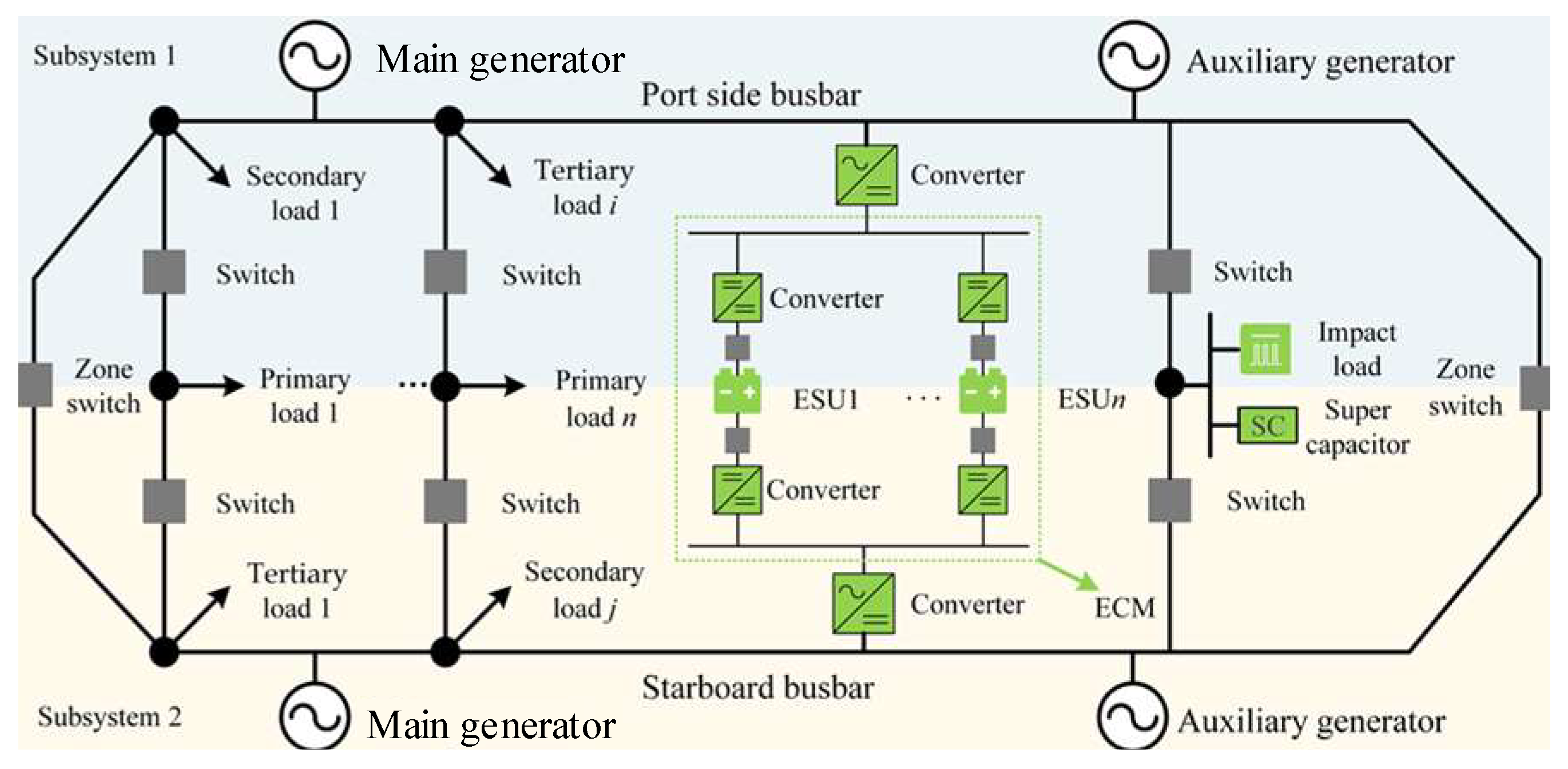
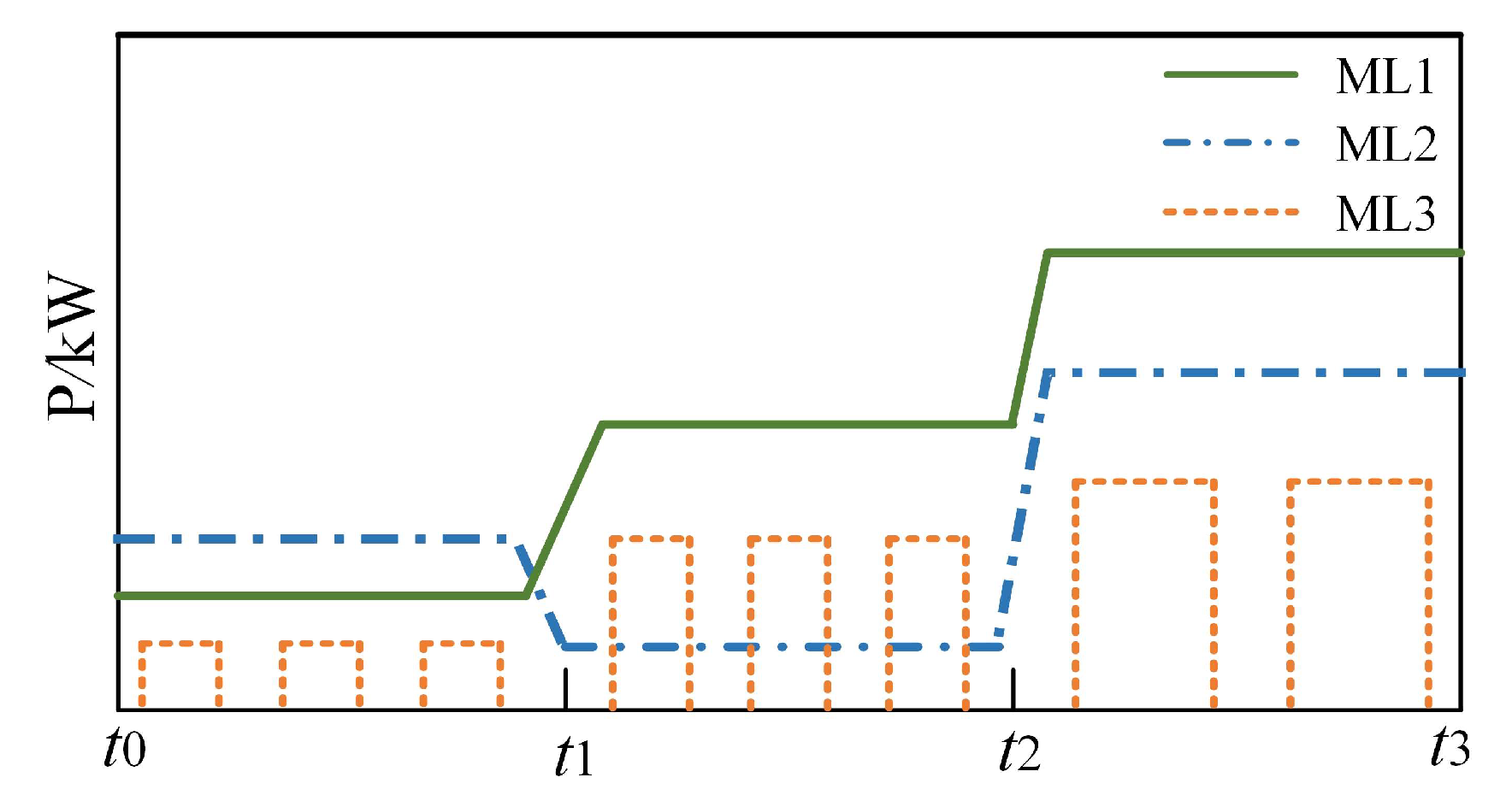
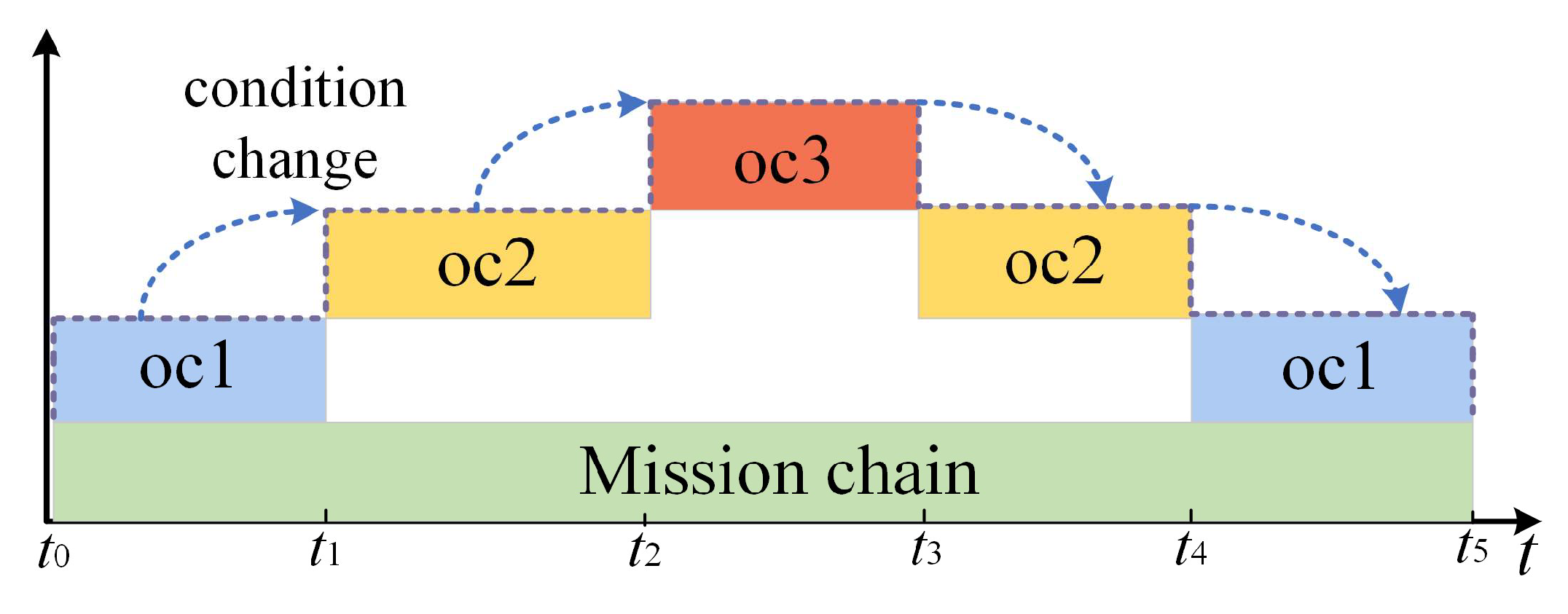


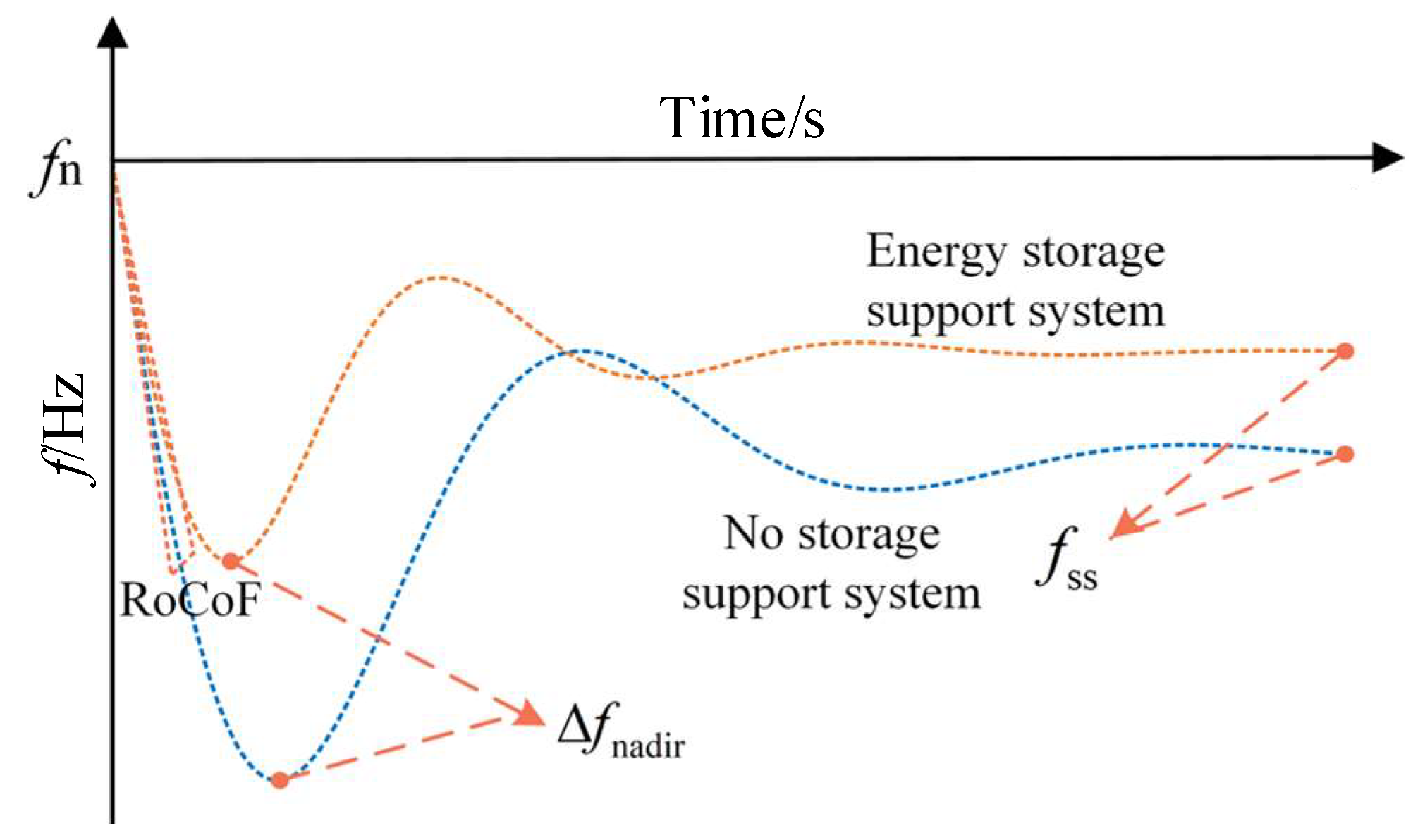


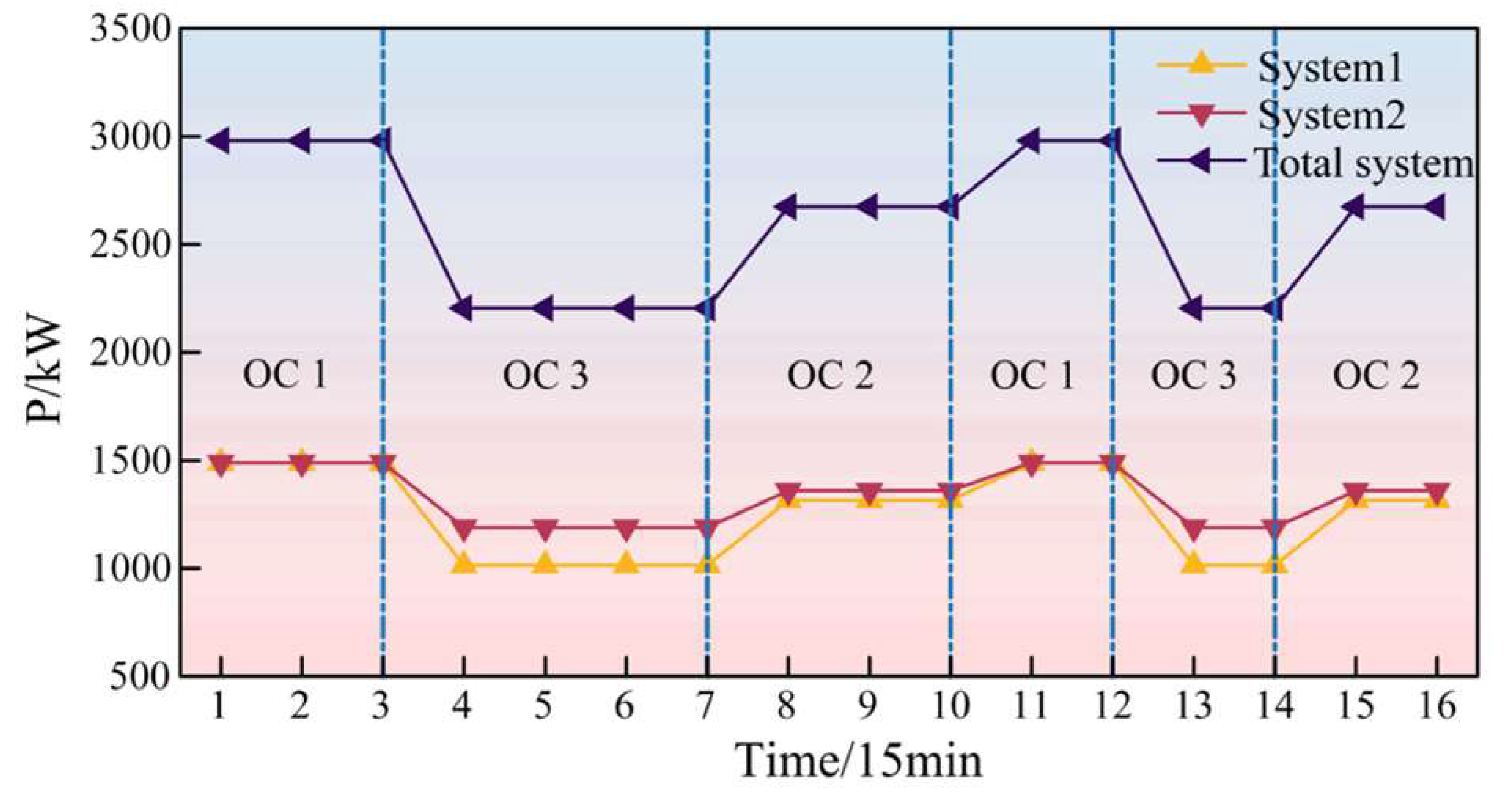

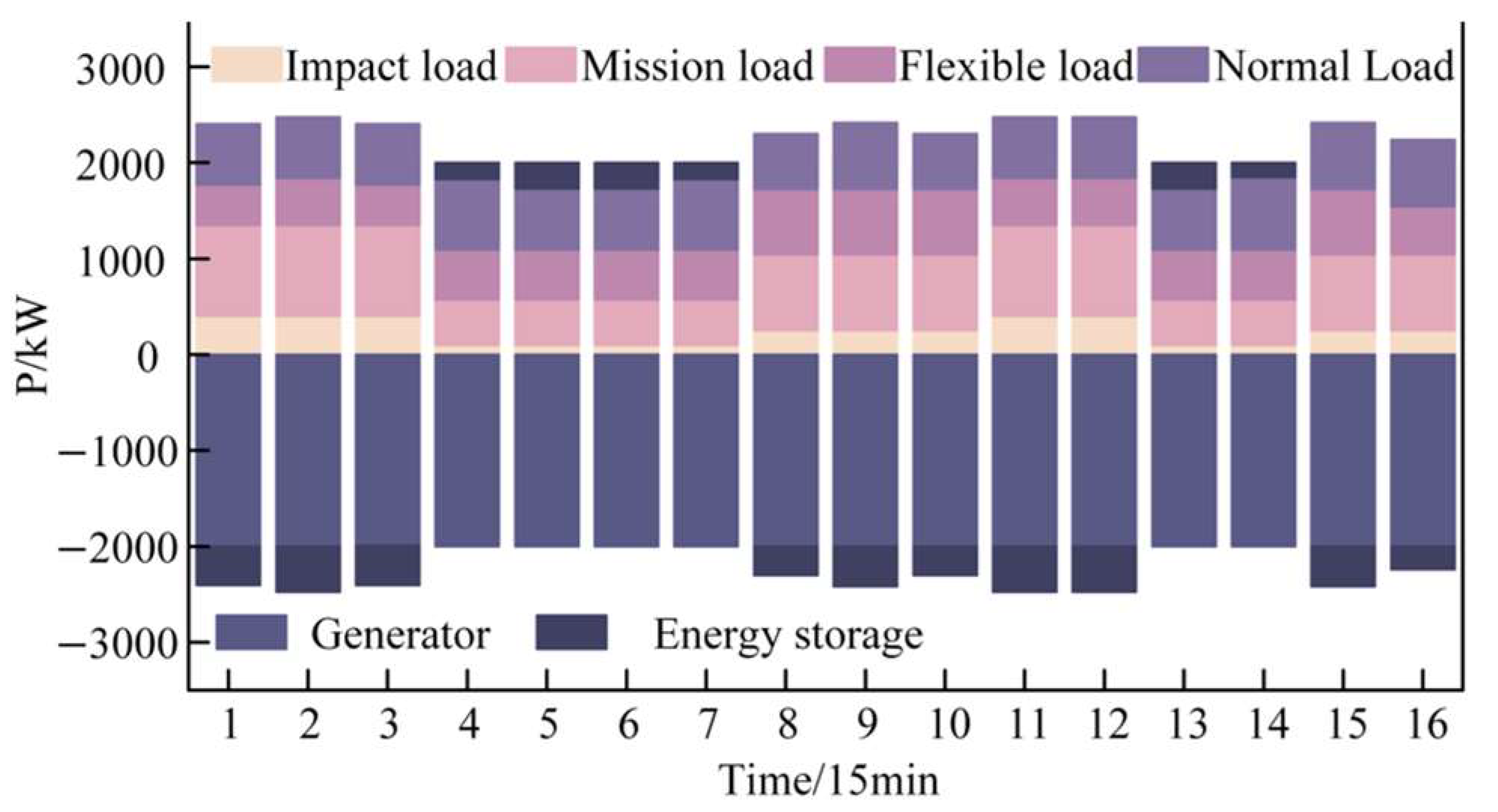
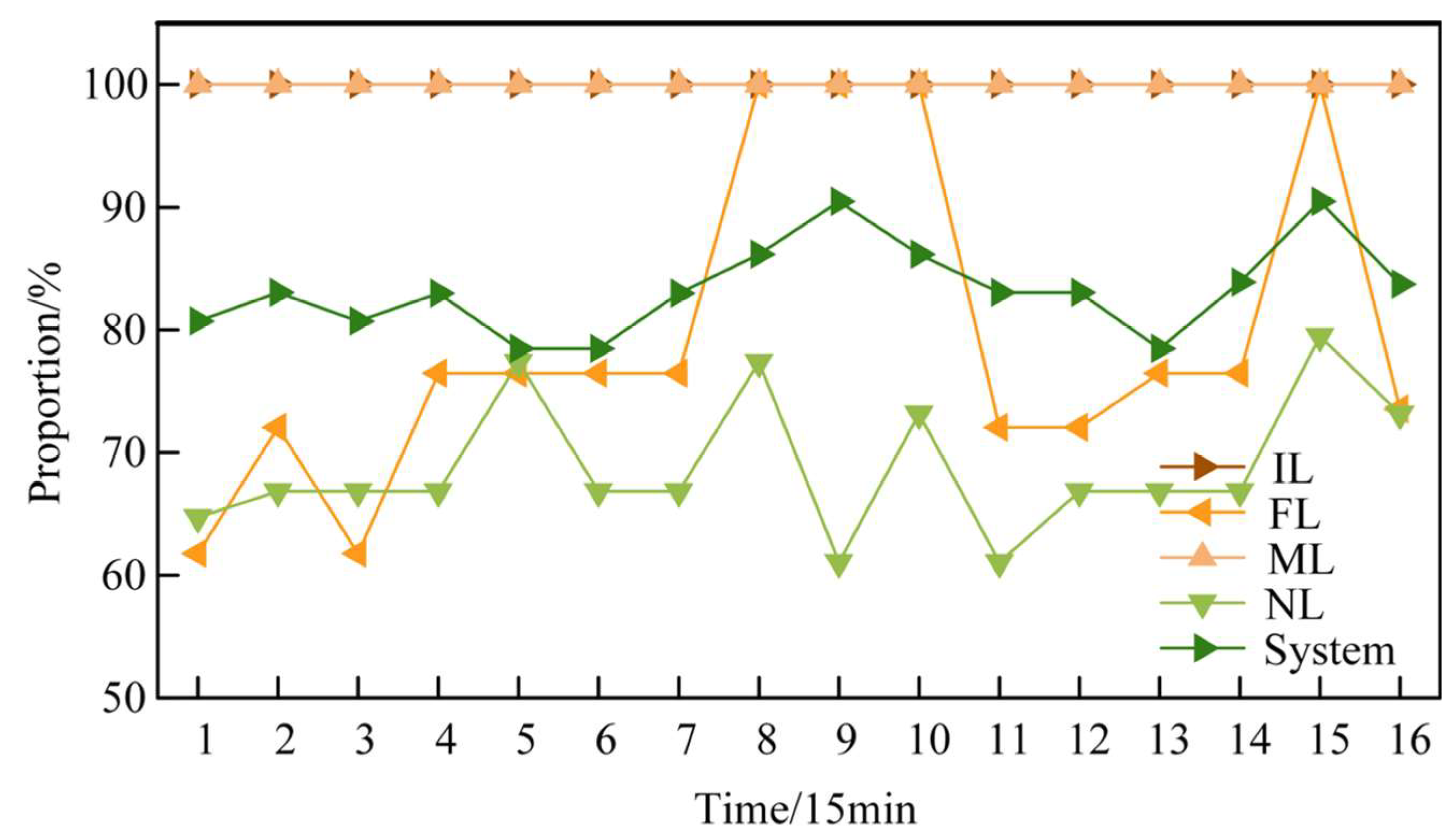

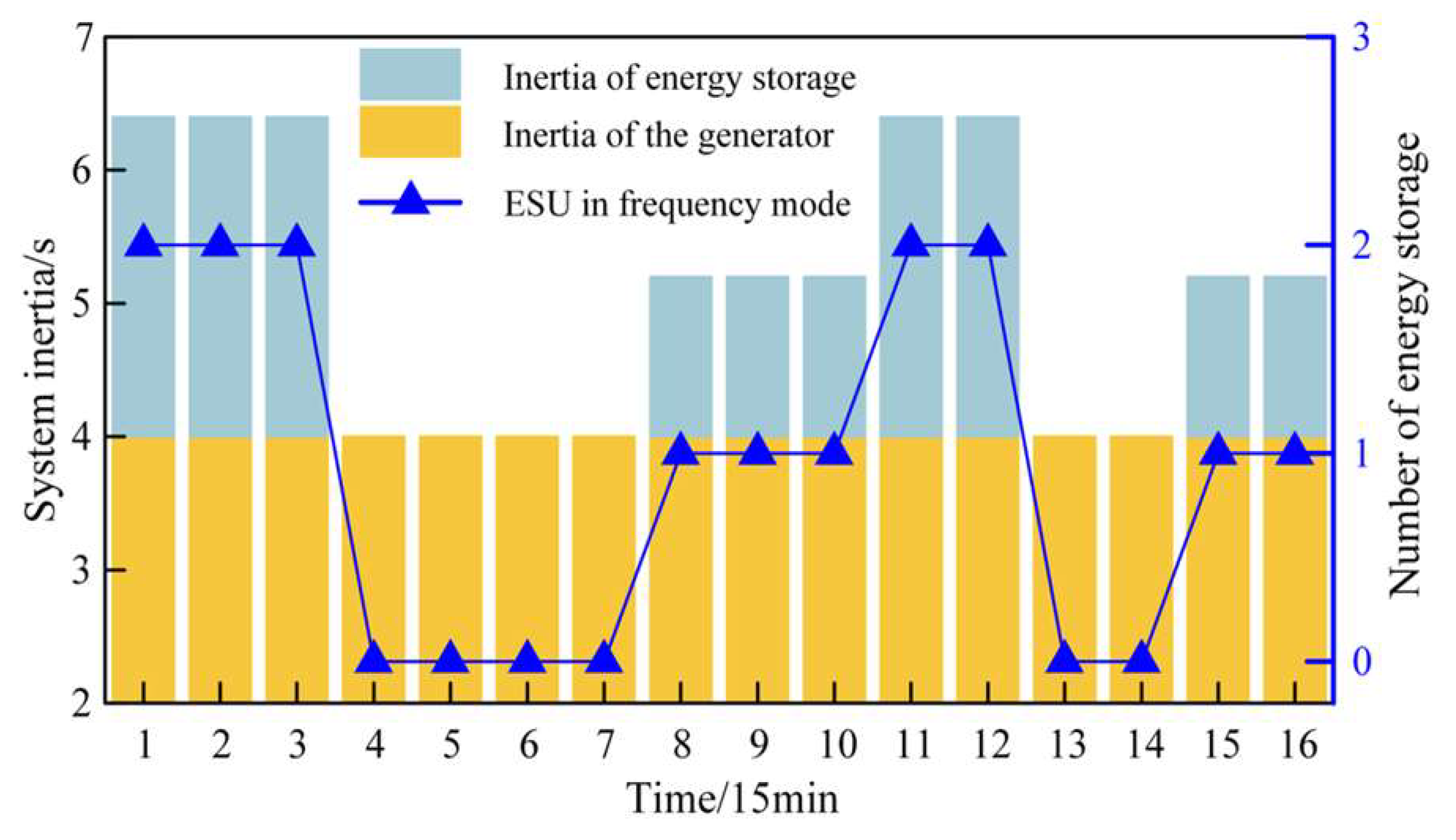
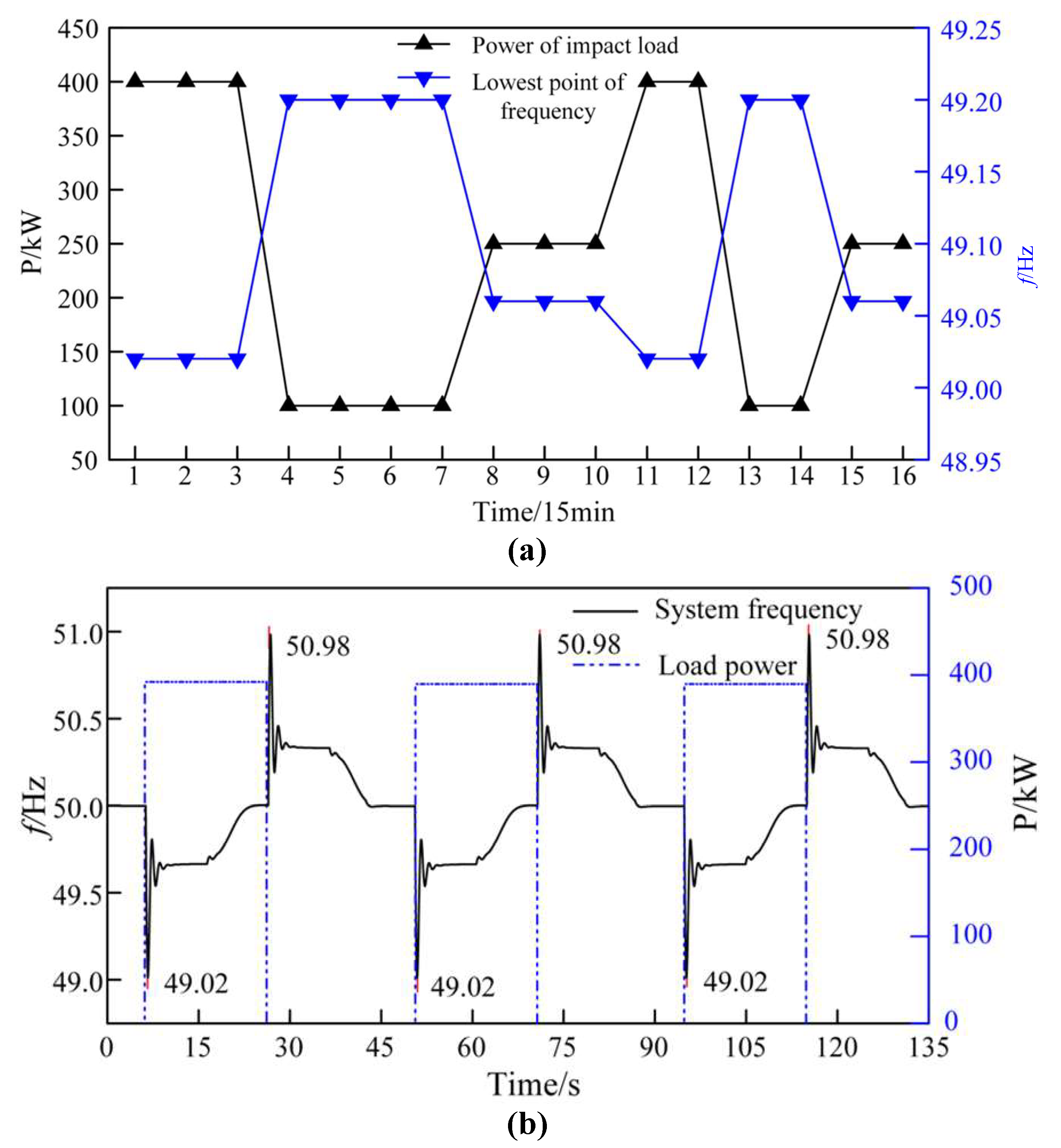


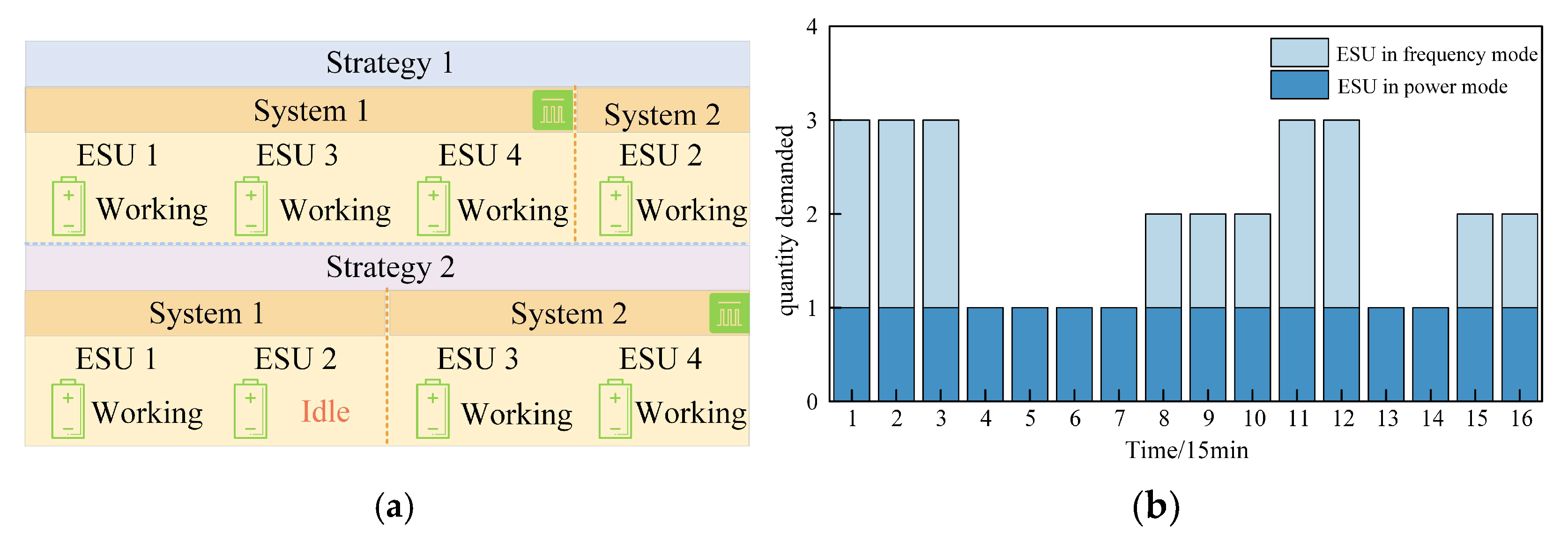
| Strategy | Power Constraint | Frequency Constraint | The Total of the Power Values of the Loads | The Total Power-Weighted Value of the Load |
|---|---|---|---|---|
| 1 | Yes | Yes | 34,640 | 530,080 |
| 2 | Yes | Yes | 33,710 | 518,450 |
| 3 | Yes | Yes | 34,635 | 485,235 |
| 4 | Yes | No | - | - |
| 5 | No | No | - | - |
Disclaimer/Publisher’s Note: The statements, opinions and data contained in all publications are solely those of the individual author(s) and contributor(s) and not of MDPI and/or the editor(s). MDPI and/or the editor(s) disclaim responsibility for any injury to people or property resulting from any ideas, methods, instructions or products referred to in the content. |
© 2025 by the authors. Licensee MDPI, Basel, Switzerland. This article is an open access article distributed under the terms and conditions of the Creative Commons Attribution (CC BY) license (https://creativecommons.org/licenses/by/4.0/).
Share and Cite
Bai, C.; Tan, Y.; Wei, F.; Lin, X. Optimal Operation Strategy of Ship Power System Under Battle Damage for Enhancing Survivability in Long-Term Missions. Energies 2025, 18, 3615. https://doi.org/10.3390/en18143615
Bai C, Tan Y, Wei F, Lin X. Optimal Operation Strategy of Ship Power System Under Battle Damage for Enhancing Survivability in Long-Term Missions. Energies. 2025; 18(14):3615. https://doi.org/10.3390/en18143615
Chicago/Turabian StyleBai, Chunhan, Yun Tan, Fanrong Wei, and Xiangning Lin. 2025. "Optimal Operation Strategy of Ship Power System Under Battle Damage for Enhancing Survivability in Long-Term Missions" Energies 18, no. 14: 3615. https://doi.org/10.3390/en18143615
APA StyleBai, C., Tan, Y., Wei, F., & Lin, X. (2025). Optimal Operation Strategy of Ship Power System Under Battle Damage for Enhancing Survivability in Long-Term Missions. Energies, 18(14), 3615. https://doi.org/10.3390/en18143615





